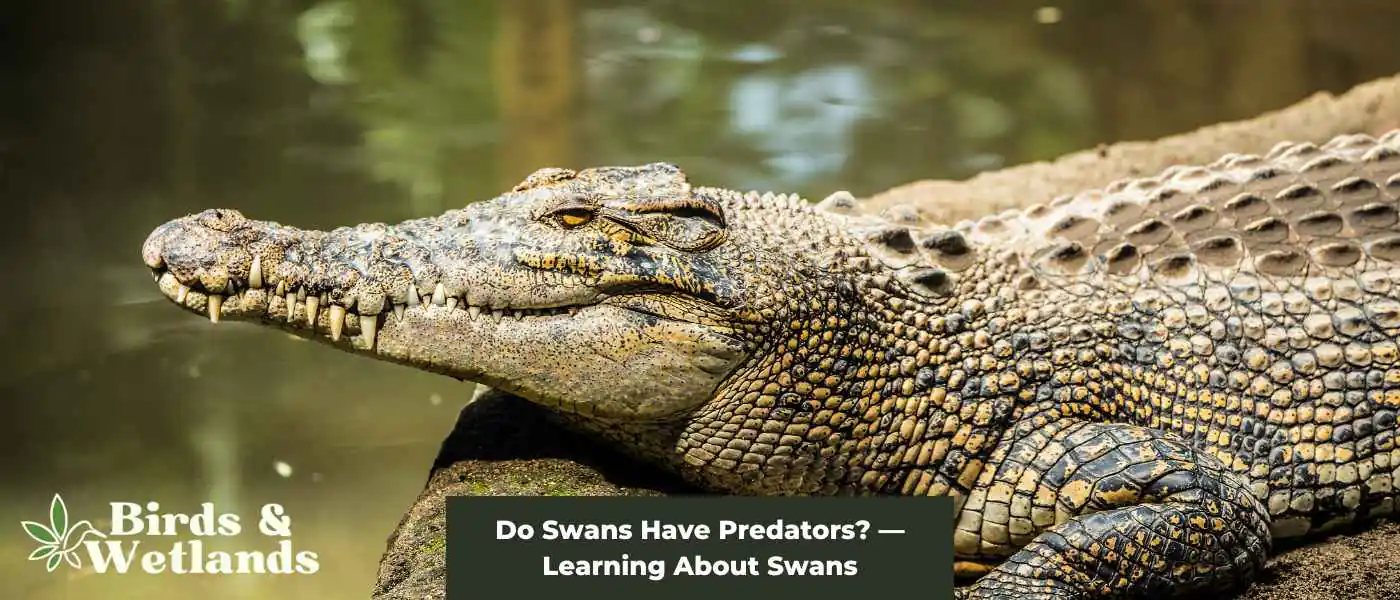In the natural world, swans occupy a unique place in the food chain, as they are both predators and prey.
Unfortunately, many predators prey on swans, and these elegant birds are often at risk of being attacked. From carnivorous animals to opportunistic humans, swans must constantly be on guard to protect themselves and their young.
In this blog post, we will explore the various predators that threaten the lives of swans and discuss ways to help protect these beloved birds.
Key Takeaways on Swan Predators
- Swans are known for their herbivorous diet of aquatic vegetation. But they supplement their diet with aquatic insects and invertebrates.
- Young cygnets eat the same food as their parents.
- Like most birds, swans are vulnerable to most predators during molting, egg incubation and migration.
Understanding Swans
North American swans include the Trumpeter swans, Mute Swans and Tundra Swans. Other species include black-necked swans and black swans.
The mute swan is native to Europe and Asia. It gets its name because it is generally quieter than other swan species, although it can make various vocalizations, including honks, hisses, and whistles.
The trumpeter swan is a large species of swan native to North America. Adult trumpeter swans are among the heaviest birds native to the continent, with males are generally larger weighing up to 25 pounds and females weighing up to 20 pounds. It is the counterpart of the whooper swan.
The trumpeter swans live in marshes, ponds, rivers, streams, wetlands and lakes.
The tundra swan, also known as the whistling swan, is a medium-sized swan native to North America and Eurasia. It is smaller than the trumpeter swan, with a body length of approximately 3-4 feet and a wingspan of up to 6 feet.
The tundra swan is a migratory bird, and populations in North America migrate south to winter in the United States and Mexico. They return to the Arctic tundra to breed and nest in the spring.
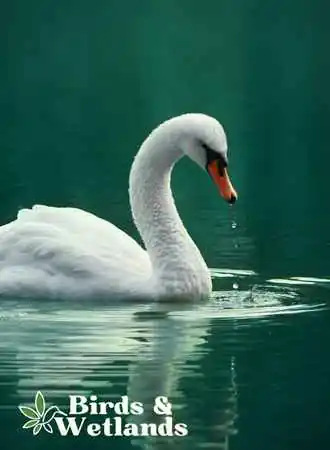
Diet
Swans eat aquatic plants but are omnivorous birds with varied diets. In the wild, swans feed on grasses, duck potato and grains and eat insects, snails, and small fish. Some species of swans, such as the mute swan, have been known to scavenge for food in urban areas and may eat bread, and other scraps thrown to them by humans.
Swans have long necks, webbed feet and sharp beaks that they use to forage for food in the water. They are often seen “upending” or tipping their bodies upside down to reach plants and other food at the bottom of ponds and lakes.
Swans have a special gland near their tails that secretes oil that they use to waterproof their feathers, which allows them to swim and dive underwater to search for food.
Reproduction
The age at which swans reach sexual or reproductive maturity can vary depending on the species of swan and the environmental conditions in which they live. Swans generally reach sexual maturity at around 3-5 years, although some species may take longer to reach this stage.
Once swans reach sexual maturity, they are capable of reproducing and will typically seek out a mate to form a monogamous pair bond. During courtship, swans are known for their elaborate visual displays, synchronized swimming, head bobbing and grunting sounds.
Swans are known to keep the same partners for their entire lives and often mate for life, although some pairs may split up if one of the partners dies or is unable to produce offspring.
Female swans lay between 3 to 9 eggs and incubate them for a period of 30 to 35 days. How many eggs and the incubation period depend on the habitat and species of the swan.

When are swans the most vulnerable to natural predators?
Swans may be more vulnerable to predator attacks at different times depending on the species of swan and the location. In general, however, swans may be more vulnerable to predator attacks during the following times:
Molting
Swans molt or shed and replace their feathers once a year. The timing of the molting process can vary depending on the species of swan and the location.
In many cases, swans begin molting after the breeding season, when they have finished raising their young.
For example, in the US and Canada, trumpeter swans typically molt in late summer or early fall after the chicks have fledged and the adults have finished caring for them. Mute swans in Europe may also molt after the breeding season, typically in July or August.
Even though breeding pairs don’t molt together, they are still vulnerable to predation. During this time, they may become more vulnerable to predators and may need to seek out safe, sheltered areas to rest and protect themselves from predators and other animals.
Breeding or Nesting Season
Swans may be more vulnerable during the breeding and nesting season due to the energy and resources they invest in reproduction and raising their young. During this time, swans may be more focused on caring for their eggs and chicks and may be less able to defend themselves against predators or other threats. Additionally, if a baby swan gets separated from its parents, it becomes easy prey.
In some cases, swans may be more aggressive during breeding to protect their nests and young. This can be especially true of male swans, which may be more territorial and more likely to attack perceived threats. However, swans are generally non-aggressive and are more likely to try to avoid conflicts whenever possible.
Swans may also be more vulnerable during the mating season due to the limited mobility resulting from sitting on eggs or caring for chicks. This can make it more difficult for them to escape predators or other dangers and may increase the risk of injury or loss of life.
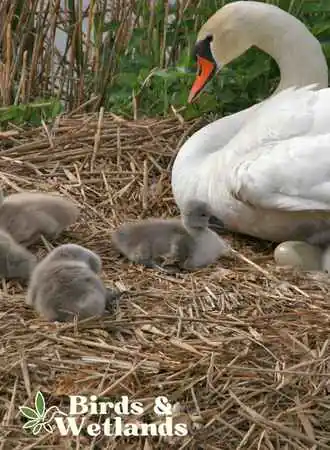
Migration
Swans may be more vulnerable to predation during migration due to the energy and resources they expend while flying long distances.
During migration, swans fly in V formation to conserve energy and watch for potential predators. Still, they are vulnerable to attacks. They may also be at greater risk of collision with humans, particularly if they are flying over urban or suburban areas.
Migrating swans may be at risk from various predators, depending on their location and the predator species.
For example, swans may be at risk from hawks or owls flying over open areas and from mammals such as foxes or coyotes while resting on the ground. Swans may also be at risk of collision with humans, particularly if they are flying at low altitudes or near airports.
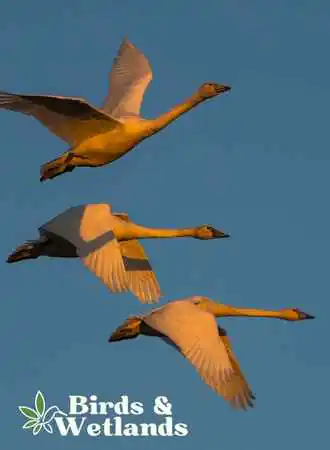
What predators prey on swans?
Swans are large, majestic birds known for their grace and beauty. While they may seem delicate and peaceful, swans are quite tough and can defend themselves against various predators. Baby swans or cygnets are the most vulnerable.
- Coyotes
- Foxes
- Dogs
- Hawks
- Eagles
- Owls
- Snapping Turtles
- Weasels
- Mink
- Raccoons
- Snakes
- Crocodiles
- Alligators
Coyotes, raccoons and snakes are among the most common predators of swan eggs.
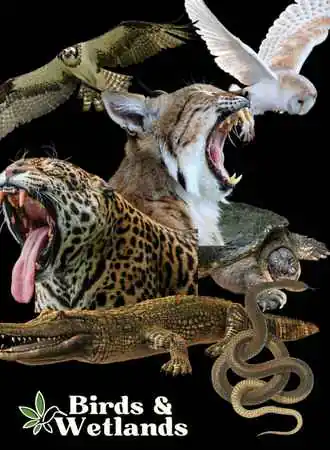
How do swans defend themselves against predators?
Swans are generally non-aggressive birds and often try to avoid conflicts whenever possible. However, they can defend themselves against predators, if necessary, using various methods.
One common method of defense is flight. Swans like the black swan are strong fliers and can often escape danger by taking to the air. They may also use their wings to intimidate predators or deter them from approaching.
Swans may also use their size and strength to defend themselves against predators. They have long, powerful wings and strong legs, which they can use to attack or fend off threats.
Some swans, like mute swans, can attack humans or other swans approaching their nests or young using their wings and beaks as weapons.
Swans may also use their vocalizations to defend themselves against predators. They can make various sounds, including honks, hisses, and whistles, which they may use to communicate potential threats or alert others to danger.
How to Protect Swans From Predators
Here are a few ways to protect swans from predators:
- Provide a safe, secure nesting area. Swans like the black-necked swan may be more vulnerable to predators while sitting on eggs or caring for chicks. Providing a safe, secure nesting area can help to reduce the risk of attack by predators such as raccoons, minks, or snakes.
- Avoid feeding swans. While it may be tempting to feed swans, it is generally not recommended as it can lead to a dependency on human food and may make them more vulnerable to predators. Swans can find their own food and do not require supplemental feeding.
- Protect wetland habitats. Wetland habitats are important for swans and other waterfowl, providing a safe place to rest, feed, and breed. Protecting wetland habitats ensures swans can access the resources they need and are less vulnerable to predators.
- Avoid disturbing swans during the breeding season. Swans may be more sensitive and aggressive during the nesting season, focusing on protecting their eggs and chicks. Avoiding disturbance during this time can help to reduce the risk of conflict and ensure the safety and well-being of the birds.
- Educate others about swan conservation. Helping to educate others about the importance of swan conservation can raise awareness and encourage people to take action to protect these beautiful birds.
What other dangers pose a threat to swans?
Swan populations in the North American continent is declining even though they’re not considered endangered or vulnerable. This status is due to various factors such as threats posed by pollution, habitat loss, lead poisoning, climate change, power lines and predation.

